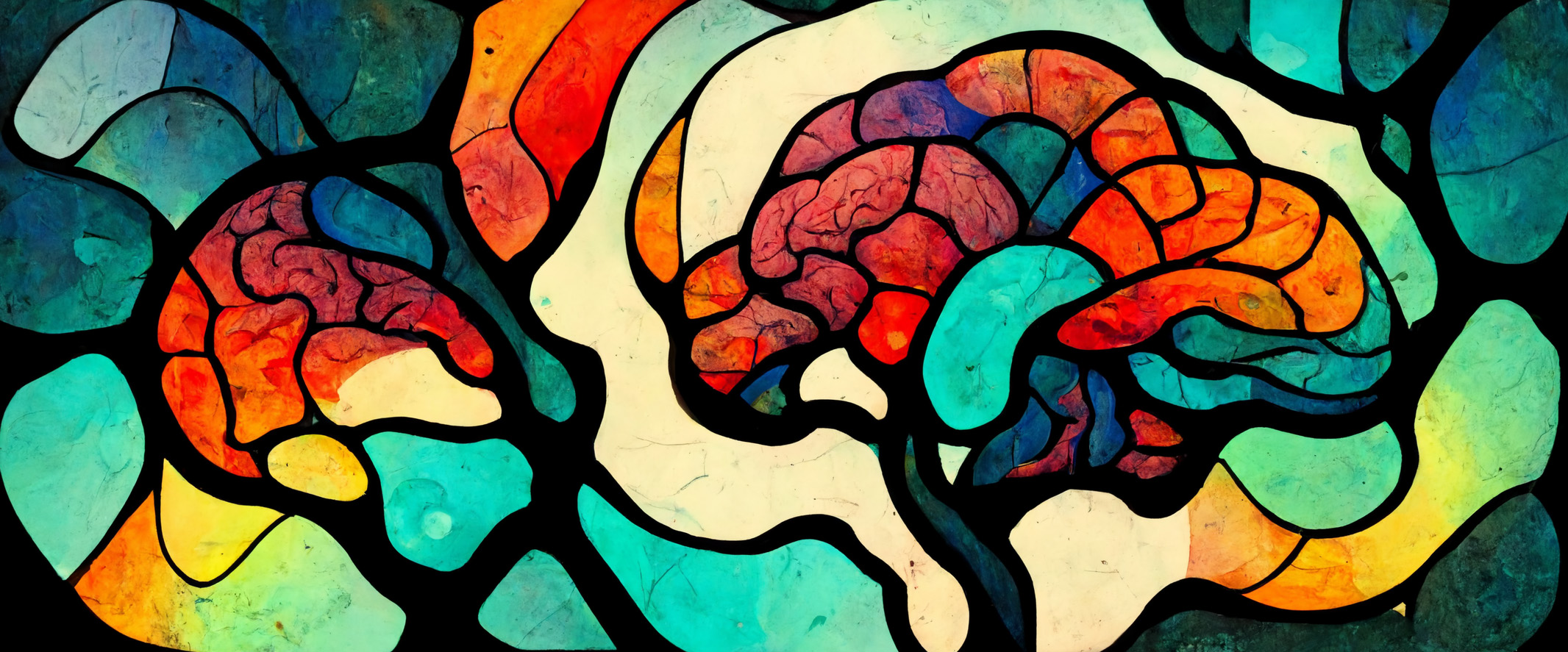By Jennifer Gray M.S.
From Trauma to Triumph: A Neuroscientist’s Perspective on Living with Trauma-Induced Derealization Disorder
I sit quietly in class, intently listening to my professor talk about the molecular intricacies of chandelier neurons—my favorite kind. Suddenly, without warning, I begin to feel like I’m floating slowly up into a thick sea of fog. Sounds seem far away; colors are too bright; my desk is too cold. I look down at my arm, furiously writing detailed notes—it’s not my arm. I hear an echoing sound—my professor is asking me a question, but for some reason, I can’t comprehend what he is saying. Words evade me, and suddenly I begin to panic. Hyperventilating as quietly as I can, I consciously fight the overwhelming feeling that I do not belong to my body. However, I know how to stay calm, as I’ve fought these feelings before. They are just a taste of the symptoms I have experienced as a person with trauma-induced derealization disorder (TID).
“Trauma” is a term casually thrown around in conversation. However, the actual nature of trauma and its impact on the body remains elusive. TID is a pervasive condition characterized by a persistent feeling of detachment from one’s surroundings or a sense of unreality, considered a form of mental escape from the full experience of reality, and often arises due to trauma, including experiences such as physical/emotional abuse, neglect, natural disasters, assault, or other life-threatening situations.1,2,3 People with TID often describe feeling like they are in a dream, watching themselves from outside their bodies, or feeling that the world around them is not entirely real. An estimated 50% of the US population experiences dissociative symptoms at some point in their life, and more than 2% of the population has been diagnosed with a dissociative disorder.2,4 Here, we will explore the neuroscience research behind derealization disorder and the critical roles that trauma and neurodivergence play in our understanding and treatment of TID.
It is well known that trauma can negatively impact a person’s quality of life, significantly increasing the chances of developing depression, anxiety, post-traumatic stress disorder, and other psychiatric illnesses following the traumatic event(s).5 However, how external traumas impart lasting changes to the brain is not fully understood. Past studies show that patients diagnosed with TID have decreased volume in many key brain regions involved in regulating emotions, processing memories, integrating sensory information, and constructing a person’s sense of self.6,7,8,9 Symptoms associated with TID arise from disrupted connectivity between these regions.
One brain region particularly impacted by TID is the amygdala, which is responsible for processing feelings of fear and anxiety. When a person experiences a traumatic event, sensory information is relayed to the brain and activates the amygdala during emotional processing. In turn, the amygdala, along with the pituitary gland, sends electrical and chemical signals to a brain region responsible for homeostatic and hormonal regulation called the hypothalamus. The hypothalamus then releases a hormone called corticotropin-releasing hormone (CRH), which triggers the release of stress hormones like cortisol from the adrenal glands and activates the body’s natural threat response.10 In cases of TID, the amygdala is hyperactive, and the brain cannot discern between normal or traumatic stimuli.7,8,9,11,12 When presented with emotional/physical triggers or overstimulating environments, people with TID often experience a very real physiological response to trauma, dissociating from their surroundings as a subconscious way to cope with overwhelming emotions.12
Another key area impacted by TID is the prefrontal cortex (PFC), a brain region responsible for executive functions like decision-making, problem-solving, and emotional regulation.6,11,12 Individuals with TID have decreased baseline neural activity in the PFC, which may contribute to feelings of confusion, brain fog, and detachment from reality.6,11,12,13 In addition, TID significantly impacts how our brains form and store memories. During and after a traumatic event, memories may be stored in our PFC, limbic system, and hippocampus in a fragmented and disorganized way, making it difficult for the brain to process and integrate them. This may lead to memory blockades and difficulty forming and retrieving memories down the road.7,14 However, people living with TID and research on dissociative disorders remain highly stigmatized, understudied, overgeneralized, and misrepresented as a whole.
In order to holistically understand the neural underpinnings of TID and move towards effective treatment, medical communities must put trauma-informed intervention at the forefront of their efforts. In addition, these communities must increase the representation of neurodivergent individuals, i.e., individuals differing in mental or neurological function from what is considered typical. Medical racism, sexism, and the stigmatization of neurodivergent communities have been interwoven into the fabric of most scientific research. Historically marginalized groups experiencing trauma are often overlooked, misdiagnosed, subjected to harmful research practices, or left untreated due to extreme medical and/or cultural stigma.15,16
Many studies informing the current medical literature today exclude marginalized patient populations and patient narratives, effectively hindering our neurological understanding (and subsequent treatment) of people impacted by trauma. In 2011, researchers found that Black, Hispanic, and Asian individuals were 2-3 times less likely to seek treatment for post-traumatic stress disorder (PTSD) and other trauma-related disorders than White individuals, further highlighting disparities in medical treatment.17 In order to fully capture the nature of TID, we must recognize the compounded impact trauma has on marginalized populations, invest in accessible and culturally sensitive treatment options, create a safe and supportive environment for all patients, and include the unique lived experiences and backgrounds of patients in all research efforts. By recognizing the prevalence and impact of trauma and centering patient perspectives, we can work towards more equitable research that meets the needs of all people impacted by trauma and brain illness.
As for me, a queer, disabled neuroscientist with TID, I can feel the tide changing. Every year I work as a researcher and science writer, I see greater representation in our field. It appears the barriers crumbling and the years of disillusionment and stigma against brain illness slowly washing away. However, on days when my symptoms are particularly prevalent, when working at a ‘normal’ pace feels like moving through wet cement, I stop and think to myself: Does anyone understand my experience? Where is the professional, emotional, and financial support for others like me? Where is the representation of neurodivergent scientists in our own treatment, in our own healing, in our own narrative? TID is just one small part of me, but it is a part of me that I hold with pride and triumph. Neuroscience and medical communities, and even society as a whole, are slowly letting go of long-held stigmas against mental health, accepting the impact of individual and collective trauma and its effect on our brains. Yet, the road ahead toward true representation and trauma-informed treatment is undoubtedly long and arduous. It is a complex irony indeed that neurodivergent and underrepresented peoples have always led their own battles. In that thread, we will not stop until we achieve trauma-informed culture.
References
- Michal, M., Röder, C., Mayer, J., Lengler, U., & Krakow, K. (2007). Spontaneous dissociation during functional MRI experiments. Journal of psychiatric research, 41(1-2), 69–73. https://doi.org/10.1016/j.jpsychires.2005.04.011
- Diseth T. H. (2005). Dissociation in children and adolescents as reaction to trauma–an overview of conceptual issues and neurobiological factors. Nordic journal of psychiatry, 59(2), 79–91. https://doi.org/10.1080/08039480510022963
- Stiglmayr, C. E., Ebner-Priemer, U. W., Bretz, J., Behm, R., Mohse, M., Lammers, C. H., Anghelescu, I. G., Schmahl, C., Schlotz, W., Kleindienst, N., & Bohus, M. (2008). Dissociative symptoms are positively related to stress in borderline personality disorder. Acta psychiatrica Scandinavica, 117(2), 139–147. https://doi.org/10.1111/j.1600-0447.2007.01126.x
- Depersonalization/Derealization Disorder: Symptoms & Treatment. (2020, October 15). Retrieved February 10, 2023, from https://my.clevelandclinic.org/health/diseases/9791-depersonalizationderealization-disorder#:~:text=It%20occurs%20in%20less%20than,depersonalization%2Fderealization%20to%20need%20treatment.
- Bosch, J., Mackintosh, M.-A., Wells, S. Y., Wickramasinghe, I., Glassman, L. H., & Morland, L. A. (2020). PTSD treatment response and quality of life in women with childhood trauma histories. Psychological Trauma: Theory, Research, Practice, and Policy, 12(1), 55–63. https://doi.org/10.1037/tra0000468
- Lotfinia, S., Soorgi, Z., Mertens, Y., & Daniels, J. (2020). Structural and functional brain alterations in psychiatric patients with dissociative experiences: A systematic review of magnetic resonance imaging studies. Journal of psychiatric research, 128, 5–15. https://doi.org/10.1016/j.jpsychires.2020.05.006
- Woon, F. L., Sood, S., & Hedges, D. W. (2010). Hippocampal volume deficits associated with exposure to psychological trauma and posttraumatic stress disorder in adults: a meta-analysis. Progress in neuro-psychopharmacology & biological psychiatry, 34(7), 1181–1188. https://doi.org/10.1016/j.pnpbp.2010.06.016
- Simeon, D., Guralnik, O., Knutelska, M., Hollander, E., & Schmeidler, J. (2001). Hypothalamic-pituitary-adrenal axis dysregulation in depersonalization disorder. Neuropsychopharmacology: official publication of the American College of Neuropsychopharmacology, 25(5), 793–795. https://doi.org/10.1016/S0893-133X(01)00288-3
- Simeon, D., Knutelska, M., Yehuda, R., Putnam, F., Schmeidler, J., & Smith, L. M. (2007). Hypothalamic-pituitary-adrenal axis function in dissociative disorders, post-traumatic stress disorder, and healthy volunteers. Biological psychiatry, 61(8), 966–973. https://doi.org/10.1016/j.biopsych.2006.07.030
- Spencer, R. L., & Deak, T. (2017). A users guide to HPA axis research. Physiology & behavior, 178, 43–65. https://doi.org/10.1016/j.physbeh.2016.11.014
- Sierra, M., Phillips, M. L., Ivin, G., Krystal, J. H., & David, A. S. (2005). Cognitive neuroscience and derealization disorder: a functional magnetic resonance imaging study. Journal of Neurology, Neurosurgery & Psychiatry, 76(4), 494-501.
- Nicholson, A. A., Sapru, I., Densmore, M., Frewen, P. A., Neufeld, R. W., Théberge, J., McKinnon, M. C., & Lanius, R. A. (2016). Unique insula subregion resting-state functional connectivity with amygdala complexes in posttraumatic stress disorder and its dissociative subtype. Psychiatry research. Neuroimaging, 250, 61–72. https://doi.org/10.1016/j.pscychresns.2016.02.002
- Sündermann, O., Hauschildt, M., & Ehlers, A. (2013). Perceptual processing during trauma, priming and the development of intrusive memories. Journal of behavior therapy and experimental psychiatry, 44(2), 213–220. https://doi.org/10.1016/j.jbtep.2012.10.001
- van der Kolk, B. A., & Fisler, R. (1995). Dissociation and the fragmentary nature of traumatic memories: overview and exploratory study. Journal of traumatic stress, 8(4), 505–525. https://doi.org/10.1007/BF02102887
- Keane, T. M., Marshall, A. D., & Taft, C. T. (2006). Posttraumatic stress disorder: etiology, epidemiology, and treatment outcome. Annual review of clinical psychology, 2, 161–197. https://doi.org/10.1146/annurev.clinpsy.2.022305.095305
- McClendon, J., Dean, K. E., & Galovski, T. (2020). Addressing diversity in PTSD treatment: Disparities in treatment engagement and outcome among patients of color. Current Treatment Options in Psychiatry, 7, 275-290.
- Roberts, A. L., Gilman, S. E., Breslau, J., Breslau, N., & Koenen, K. C. (2011). Race/ethnic differences in exposure to traumatic events, development of post-traumatic stress disorder, and treatment-seeking for post-traumatic stress disorder in the United States. Psychological medicine, 41(1), 71–83. https://doi.org/10.1017/S0033291710000401


